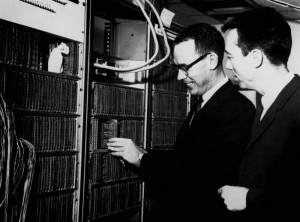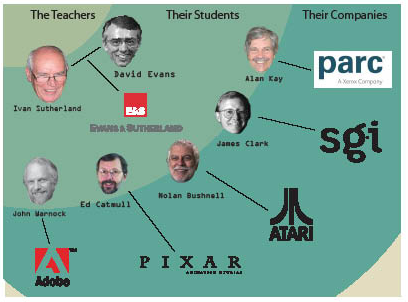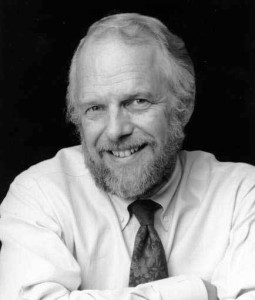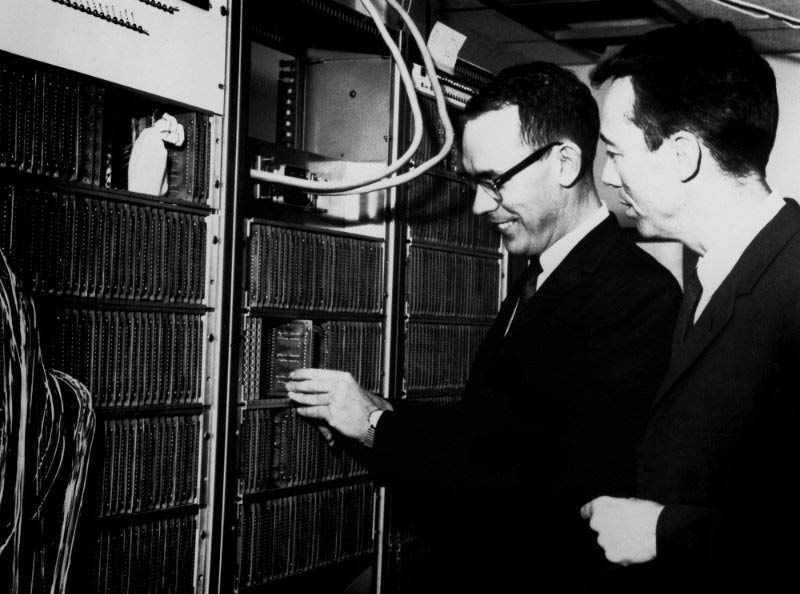
How Utah scientists David Evans and Ivan Sutherland pioneered the computer graphics department at the University of Utah with graduates who would go on to change the world.
David C. Evans (1924–1998), attended the University of Utah to study electrical engineering, eventually earning a doctorate degree in physics. After a short stint as project manager at the Bendix Corporation working on a version of an early personal computer, he joined the faculty at the University of California, Berkeley, pioneering key developments in the field of virtual memory.
Ivan E. Sutherland (1938) studied electrical engineering at the Carnegie Institute of Technology (now Carnegie Mellon University), received a Master’s degree from Caltech, and a Ph.D. form MIT. He invented Sketchpad and is credited with being the father of computer graphics.
In 1965, the University of Utah recruited Evans to establish a state of the art computer science program. In 1968, he convinced his friend from Berkeley Ivan Sutherland, a fellow computer graphics pioneer, to leave his teaching position at Harvard and move to Utah, which he agreed to with the condition they start a computer graphics company together.
This power collaboration shaped the history of the computer industry and built one of the most influential university computer graphics programs in the country. Students were encouraged to experiment and find creative solutions based on the theory computers could be used interactively for a variety of tasks.

Evans and Sutherland envisioned the use of computers as simulators by using graphics technology to replace real objects, aiding in cheaper costs for military and other development projects. The genesis of the Evans and Sutherland Computer Corporation (E&S) started in the barracks on the University of Utah campus with students recruited from the university. E&S made advances in real-time hardware, accelerated 3D computer graphics, and printer languages, and continues today as a major supplier of military and commercial graphics systems.
The creative and inventive atmosphere Evans and Sutherland fostered as professors and employers stimulated some of the most successful minds in the field of computer science. Many of Evans and Sutherland’s students went on to further expand the field including Alan Kay, inventor of Smalltalk language; Ewin Catmull, cofounder of Pixar and currently President of Walt Disney and Pixar Animation Studios; John Warnock, the founder of Adobe; and Jim Clark, of Silicon Graphics.
In Robert Rivlin’s book The Algorithmic Image: Graphic Visions of the Computer age, he says, “Almost every influential person in the modern computer-graphics community either passed through the University of Utah or came into contact with it in some way.”
Top of Their Classes
How Ed changed the rules for making MOVIES

Edwin Catmull determined himself when he was just a teenager to make the first feature film using computers. Quite a goal for a kid who liked drawing and wanted to be a Disney animator but found that he was better at math and physics.
Ed Catmull will likely go down in history as one of the “great executives of our day,” said Disney Chairman George Mitchell. Catmull has forged a successful marriage between artists and geeks, a marriage that both groups at Pixar agree works amazingly well. So well, that out of every film Pixar has made to date there hasn’t been a single dud: Toy Story (1995), A Bug’s Life(1998), Toy Story II (1999), Monsters Inc. (2001), and the list goes on. This year Cars II has grossed $502 million worldwide thus far. Its clear that Edwin Catmull, who graduated from the University of Utah under Dave Evans and Ivan Sutherland who is at the helm of Pixar has created a Blockbuster machine. Just how has he done this?
Catmull seems to be a man who doesn’t care who gets all the credit. Most of the time John Lassater and Steve Jobs are mentioned before Ed Catmull when the media discusses Pixar, but Jobs calls Catmull, “our quiet Beatle” (like George Harrison).
Catmull describes the early days as a tough challenge. Attracting investor’s confidence who could believe in the vision of all computer generated, animated films, was difficult. But Catmull’s first big breakthrough came when Disney approached him and colleague Alvey Ray Smith, when both were working under George Lucas. Disney wanted to know if it would be possible to digitally paint the thousands of cells that previously required a huge staff to do by hand. Catmull and Ray invented a system called CAPS. Which not only automated the process but also stored every frame of the film digitally on computers — that were pioneered by Catmull’s classmate from the U of U Jim Clark at Silicone Graphics.
Despite this success, George Lucus announced amid his divorce that he wanted to sell his digital division.
After Steve Jobs was fired from Apple he was one of the few who could see the tremendous potential of using computers to make animated films. Catmull and Ray approached Jobs after they knew he had cashed out all of his stock in Apple and convinced him to approach Lucus to purchase the company.
Jobs negotiated Lucas down from $100 million to just $10 million. Jobs renamed the company “Pixar”. Jobs eventually sold the hardware division to become solely an animation film studio. The new focus allowed Catmull and his team to produce their first big hit “Luxo Jr.” which clearly demonstrated that computer animation technology could do much more than create spaceships and aid in special effects, in fact computers, at the hands of talented artists could produce endearing characters.

The key to Pixar’s early success was creating an environment where engineers collaborated with traditional animators to constantly improve the work-flow and ease of bringing characters to life. “Geeks and artists actually are a natural fit.” says Catmull. The rest is history. Catmull said after the release of Toy Story that he “felt a little lost and worried that Pixar could be a one-hit wonder” He says that there were so many companies that demonstrated early promise but failed to build lasting value that he needed to examine both what was right and what was wrong with their production process.
Catmull determined that the key to realize continued success at Pixar was to create a culture of artists and scientists who could collaborate and communicate ideas productively. Catmull insists that after every film the teams must conduct a “brain dump” and examine all the problems and look at ways to improve the process.
Pixar’s string of Blockbuster films and the innovative environment has attracted efficiency experts from the U.S. Navy to come and watch to gain insight for their own operations.
Job’s $10 million gamble paid off to the tune of $7.46 billion when Pixar went public just before the release of Toy Story. Pixar is now owned by Disney and Ed Catmul is President of Walt Disney Animation Studios.

How John Changed the rules for PUBLISHING
John Warnock began tackling some of the worlds toughest computer problems before IBM even saw the problem. His solutions changed the way in which everything we read is published.
The huge challenge in early computing was making lines, art and images transferable from the computer screen to paper, and vice-versa. Today we take this for granted. John Warnock understood the potential of computers used for publishing and he tackled many of the biggest hurdles of getting printers and computers to work well together.
Warnock co-founded Adobe in 1982 with Charles Geschke. Their first goal might sound simple: to make fonts print on paper as they appeared on the screen. But it provided a great reason for people to go buy computers. Adobe introduced “vector graphics” to artists which made it possible for line art to be easily scalable and printable without harsh jagged edges. Before the computer graphics technology that Evans and Sutherland started and Warnock and his team developed, printing billboards was still done using projector systems and stencils.
 Adobe Illustrator was their first big hit with consumers. Adobe Photoshop released in 1989 and quickly became their flagship product. Photoshop was released when most computer graphics were done by coloring individual pixels (or separate screen dots) to attempt to recreate crude images. Before Photoshop attempts to improve photos was done by skilled painters.
Adobe Illustrator was their first big hit with consumers. Adobe Photoshop released in 1989 and quickly became their flagship product. Photoshop was released when most computer graphics were done by coloring individual pixels (or separate screen dots) to attempt to recreate crude images. Before Photoshop attempts to improve photos was done by skilled painters.
Adobe Photoshop introduced layering capability, smoothing (using an algorithm called anti-aliasing).
Adobe was late in to the game in building an entire desktop publishing suite, so they purchased their competitor Aldus who offered inDesign. Today Adobe owns the world-wide market for high-end computer desktop publishing software. Adobe recently bought out a Utah company Omniture, which offers a series of tools for websites. They have been expanding in Utah County for the past nine months.


